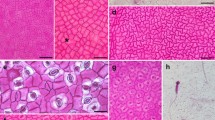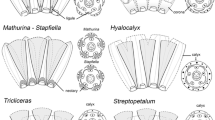Summary
Trichomes of Tremandra R.Br. ex DC., Platytheca Steetz and Tetratheca Sm. (Elaeocarpaceae, former Tremandraceae), together with two outgroup species of Elaeocarpus L., are illustrated using scanning electron microscopy, and their distribution on various plant organs is documented. Various trichomes types were identified that relate taxa: simple hairs, stellate hairs, short glandular trichomes, long glandular trichomes, and three forms of tubercules. Both outgroup and ingroup taxa have simple hairs. Stellate hairs are confirmed as unique to Tremandra. Prominent and sculptured multicelled tubercules, some bearing a stout hair, are characteristic of Platytheca. Smaller multicelled tubercules occur in both Platytheca and Tetratheca, except for the Western Australian taxon Te. filiformis Benth. (possibly plesiomorphic). Unicellular tubercules (papilla) characterise two species of Tetratheca. Short glandular trichomes, usually found on the ovary, also occur in both of these genera but not in all species (possibly secondary losses), while long glandular trichomes, usually on stems and leaves, occur only in some groups of Tetratheca. Within Tetratheca, Western Australian taxa that have five-merous flowers fall into three ‘groups’: seven species (together with one from South Australia) that have short glandular trichomes but no long glandular trichomes; six species that have long glandular trichomes but no short glandular trichomes; and four species that have both trichome types. All other species of Tetratheca have four-merous flowers and form two ‘groups’: 12 eastern species (including one from South Australia) that have both short glandular trichomes and long glandular trichomes; 4 western species and six eastern species that lack short glandular trichomes. On the basis of these characters, a phylogenetic hypothesis for the three genera is presented.
Similar content being viewed by others
References
Alford JA (1995). Two species of Tetratheca (Tremandraceae), from the Coolgardie and Austin Botanical Districts, Western Australia. Nuytsia 10: 143–149
APG (2003). An update of the Angiosperm Phylogeny Group classification for the orders and families of flowering plants: APG II. Bot J Linn Soc 141: 399–436
Bentham G (1863) Tremandreae. In: Flora Australiensis. Lovell Reeve and Co., London
Berg RY (1975). Myrmecochorous plants in Australia and their dispersal by ants. Austral J Bot 23: 475–508
Biddle JA and Christophel DC (1978). Intergynecial development in Tremandraceae. Phytomorph 28: 411–418
Boesewinkel FD (1999). Ovules and seeds of Tremandraceae. Austral J Bot 47: 769–781
Burbidge NT (1960). The phytogeography of the Australian region. Austral J Bot 8: 75–209
Butcher R (2007). New taxa of ‘leafless’ Tetratheca (Elaeocarpaceae, formerly Tremandraceae) from Western Australia. Austral Syst Bot 20: 139–160
Butcher R, Byrne M and Crayn DM (2007). Evidence for convergent evolution among phylogenetically distant rare species of Tetratheca (Elaeocarpaceae, formerly Tremandraceae) from Western Australia. Austral Syst Bot 20: 126–138
Butcher R and Sage LW (2005). Tetratheca fordiana (Elaeocarpaceae), a new species from the Pilbara of Western Australia. J Roy Soc West Aust 88: 73–76
Carlquist S (1977). Wood anatomy of Tremandraceae – phylogenetic and ecological implications. Amer J Bot 64: 704–713
Carolin RC and Tindale MD (1993). Flora of the Sydney region. Reed Books, Chatswood
Coode MJE (2004). Elaeocarpaceae. In: Kubitzki, E (eds) The families and genera of vascular plants, Vol. VI, Flowering plants, dicotyledons, Celastrales, Oxalidales, Roasales, Cornales, Ericales. Springer, Berlin, pp 135–144
Corner EJH (1976). The seeds of dicotyledons. Cambridge University Press, Cambridge
Crayn DM, Rossetto M (2003) Are “Tremandraceae” a radiation within Elaeocarpaceae: molecular evidence (conference abstract). In: 150 years: National Herbarium of Victoria and plant systematics in Australia anniversary conference. The University of Melbourne, Australia
Crayn DM, Rossetto M and Maynard D (2006). Molecular phylogeny and dating reveals an Oligo-Miocene radiation of dry-adapted shrubs (former Tremandraceae) from rainforest tree progenitors (Elaeocarpaceae). Amer J Bot 93: 1328–1342
Crisp MD and Cook LG (2007). A congruent molecular signature of vicariance across multiple plant lineages. Molec Phylogenet Evol 43: 1106–1117
Crisp MD, West JG and Linder HP (1999). Biogeography of the terrestrial flora. In: Orchard, AE (ed) Flora of Australia, 2nd edn. ABRS/CSIRO, Australia, pp 321–368
Erdtman G (1972). Pollen morphology and plant taxonomy. Angiosperms. Hafner Publishing Company, New York
Gardner C and Murray L (1992). Tremandraceae. In: Harden, GJ (ed) Flora of New South Wales. New South Wales University Press, Kensington, pp 74–78
Grieve BJ (1998). How to know Western Australian wildflowers. University of Western Australia Press, Perth
Holmgren PK, Holmgren NH, Barnett LC (1990) Index herbariorum, part 1: the Herbaria of the World. Internat. Assoc. Pl. Taxonomy, New York Bot. Garden, New York City
Jeanes JA (1996). Notes on Tetratheca procumbens Gunn ex Hook. f. (Tremandraceae). Muelleria 9: 87–92
Jeanes JA (1999). Tremandraceae. In: Walsh NG and Entwisle T (eds) Flora of Victoria volume 4. Dicotyledons: Cornaceae to Asteraceae. Inkata Press, Melbourne, pp 124–129
Johri BM, Ambegaokar KB and Srivastava PS (1972). Comparative embryology of angiosperms. Springer, Berlin
Laxmi K and Narayana LL (1987). Floral anatomy of Tetratheca affinis Endl. (Tremandraceae). J Swamy Bot Club 4: 45–47
Matthews ML and Endress PK (2002). Comparative floral structure and systematics in Oxalidales (Oxalidaceae, Connaraceae, Brunelliaceae, Cephalotaceae, Cunoniaceae, Elaeocarpaceae, Tremandraceae). Bot J Linn Soc 140: 321–381
Platnick N (1981). The progression rule or progress beyond rules in biogeography. In: Nelson, G and Roosen, D (eds) Vicariance biogeography. Columbia University Press, New York, pp 145–150
Rani RS (1995). Floral anatomy of Tremandraceae. J Indian Bot Soc 74: 69–74
Saunders ER (1939) Tremandraceae. In: Floral morphology. A new outlook with special reference to the interpretation of the gynoeceum. W. Heffer and Sons Ltd, Cambridge, pp 202–203
Savolainen V, Chase MW and Hoot SB et al. (2000a) Phylogenetics of flowering plants based on combined analysis of plastid atpB and rbcL gene sequences. Syst Biol 46: 306–362
Savolainen V, Fay MF and Albach DC et al. (2000b). Phylogeny of the eudicots: a nearly complete familial analysis based on rbcL gene sequences. Kew Bull 55: 257–309
Schuchardt T (1853) Synopsis Tremandrearum. Gottingae, Typ. expressit Officina Academica Dieterichiana (G. F. Kaestner)
Soltis DE, Soltis PS and Chase MW et al. (2000). Angiosperm phylogeny inferred from 18S rDNA, rbcL and atpB sequences. Bot J Linn Soc 133: 381–461
Stanley TD and Ross EM (1983). Flora of south-eastern Queensland. Queensland Department of Primary Industries, Brisbane
Steetz J (1845) Tremandreae. In: Lehmann J (ed) Plantae Preissianae sive Enumeratio Plantarum quas in Australasia Occidentali et Meridionali - Occidentali Annis 1838–1841. Scemptibus Meissneri, Hamburg, p 220
Steetz J (1853). Die Familie der Tremandreen und ihre Verwandtschaft zu der Familie der Lasiopetaleen: ein Beitrag für den Ausbau des natürlichen Pflanzen-Systemes. J. A. Meissner, Hamburg
Stove K (1986). Tremandraceae. In: Jessop, JP and Toelken, HR (eds) Flora of South Australia. South Australian Govt. Print. Division, Adelaide, pp 785–787
Suvartha C, Satyavathi M and Narayana LL (1984). Floral anatomy of Tetratheca efoliata FvM. (Tremandraceae). Curr Sci 53: 866–867
Thompson J (1976). A revision of the genus Tetratheca (Tremandraceae). Telopea 1: 139–215
van Tiegham MPH (1906). Quelques remarques sur les Tremandracees. Ann Sci Nat Bot 3(9): 373–386
Western Australian Herbarium (2007) Florabase. Department of Environment and Conservation. Accessed 3 May 2007. http://florabase.calm.wa.gov.au/help/copyright
Wheeler JR (1987). Tremandraceae. In: Marchant NG, Wheeler JR, Rye BL, Bennett EM, Lander NS and Macfarlane TD (eds) Flora of the Perth region, Western Australian Herbarium, Dept. of Agric. (WA), Perth, pp 464–468
Wheeler JR, Marchant NG and Lewington M (2002). Flora of the South West: Bunbury, Augusta, Denmark. Australian Biological Resources Study (ABRS), Canberra
Wright IJ and Ladiges PY (1997). Geographical variation in Eucalyptus diversifolia (Myrtaceae) and the recognition of new subspecies E. diversifolia subsp. hesperia and E. diversifolia subsp. megacarpa. Austral Syst Bot 10: 651–680
Author information
Authors and Affiliations
Corresponding author
Rights and permissions
About this article
Cite this article
Downing, T.L., Ladiges, P.Y. & Duretto, M.F. Trichome morphology provides phylogenetically informative characters for Tremandra, Platytheca and Tetratheca (former Tremandraceae). Plant Syst Evol 271, 199–221 (2008). https://doi.org/10.1007/s00606-007-0622-2
Received:
Accepted:
Published:
Issue Date:
DOI: https://doi.org/10.1007/s00606-007-0622-2




